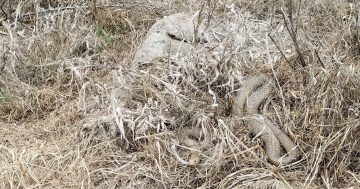
As the weather heats up this week, you can be assured snakes will be making the most of the sun and not necessarily in plain sight. Image: Canberra Snake Trackers/Facebook.
The mercury is finally climbing this week for we southerners and also on the upward trajectory is the number of social media posts about snake sightings, intercepts and engagements.
One, particularly, stood out last Saturday morning when frost still tickled the leaves of some dismal plants as one poor snake met his maker at dawn in a chook pen down the road because he happened to be in the wrong place at the wrong time.
Too right it’s the wrong time! Minus one and at 6 am out here in the country, it is no place for snakes young or old.
Anyone who read this author’s post, Close Encounters of the Slithery Kind, will be aware of my aversion to and obsession with snakes. We only have one type out here at Thuddungra – the eastern brown. So I don’t leave home much.
READ ALSO: How a Goulburn snake catcher entices his captives
After Sunday, maybe never. Not at least until I unravel this recent chilling manifestation.
So I reached out to Gavin Smith of Canberra Snake Tracking Project – whose Facebook page I follow with enormous and vicarious fascination.
Only too happy to respond, Gavin’s only caveat was that care must be taken with generalising due to notable variation of how habitat is used between individual snakes.
So – like humans – snakes wander the world the same, but differently.

Gavin Smith says the ACT study has revealed snakes are exposed to many threats. Image: Canberra Snake Trackers/Facebook.
Do you detect movement at night?
In terms of the diurnal eastern brown snakes we routinely track, no, we don’t ordinarily detect movement from them in the evening. However, on days when the ground and ambient temperatures become too hot for movement activity, snakes will tend to be inactive through the day – keeping cool in vegetation or the like – and will then sometimes forage into evening.
What’s the most surprising thing you’ve discovered since your project began?
We’re learning that even a group of snakes of the same species occupying a relatively small geographic locale can be unique behaviourally as well as morphologically. For instance, two of our tracked snakes, relocated to a new environment from two different suburbs, brumated together in the same over-wintering burrow.
Another concerning finding has been the prevalence of harm these native and protected animals endure in the wild and the extraordinary level of risk they must bear when in urban and peri-urban settings.
Threats come in multiple forms from humans, birds, cats, dogs, foxes and other snakes, to vehicles, lawnmowers, disease, parasites and habitat contamination.
Do snakes climb and swim?
Some local elapid species are more adept at these activities than others, especially red-bellied black snakes (in terms of swimming proficiency) and tiger snakes (in terms of climbing proficiency).
Why are snakes out and about at 6 am on a -1-degree Celsius day?
We have some cool-tolerant species, but this behaviour sounds very, very unusual from our perspective. Perhaps the snake had been disturbed and displaced from an overnight refuge by another animal or person.
What do people need to do when they unexpectedly encounter a snake?
The key thing to remember if you encounter a snake is that they are timid and cautious creatures and not looking for a confrontation with you. They ordinarily flee and/or hide when given the opportunity.
You simply need to keep calm and give the snake space to move out of striking range.
Snakes such as the eastern brown react to movement, especially erratic movement around their personal space, so keeping completely still reduces the likelihood of a strike or bite occurring.
It’s also worth mentioning the fang sizes of our local dangerously venomous snakes are (thankfully) relatively small compared to other species, so wearing protective clothing such as thick socks, heavy pants, leather boots and gaiters and carrying a snake bite bandage (and knowing how to apply it in the very unlikely event of a bite occurring) are sensible measures to take when out in snake-friendly areas.
So, too, is sticking to designated paths.
How do they end up in houses, cupboards, beds?
Mostly due to people leaving doors open when it’s hot, or via gaps under or at the sides of doors, weep holes or other types of access points, e.g. a cat flap.
Snakes enter properties for various reasons, following prey odours, to avoid the heat and cool down, or escaping a predator such as a cat, dog or human.
Sometimes dogs and cats will bring snakes they have captured into houses.
Once inside, snakes will seek safe places to hide including gaps behind cupboards and kickboards or behind whitegoods. Then they’ll wait for quiet moments to search for an escape route outside, which is their absolute preference.
What do you do if you find a snake in a house somewhere where snake catchers are not readily available?
Don’t approach the snake. Ideally contain it in the room that it has been sighted in and put damp towels around the bottoms of the doors.
Call a snake catcher such as myself for expert advice on how to proceed.
Each situation is different, various techniques can be utilised to encourage the snake back outside without the person having to physically interact with it.
The Canberra Snake Tracking Project Facebook page is jam-packed with information and insights, photos, videos and detailed information about the project as well as vital lifesaving information and contact numbers.







